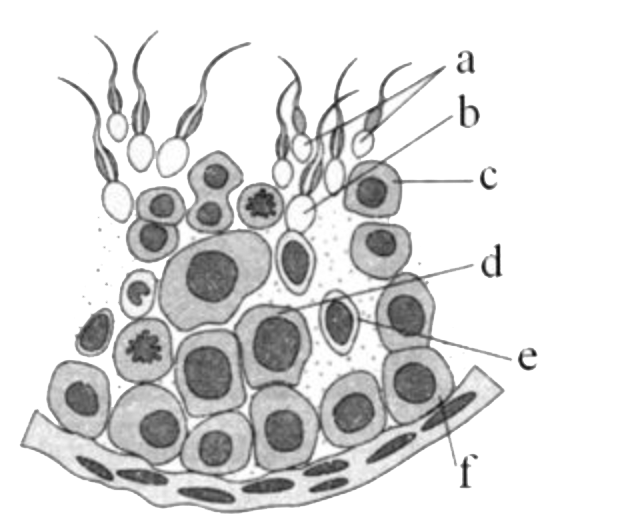Which of the following undergoes spermiogenesis :
(a) Spermatids
(b) Spermatogonia
(c) Primary spermatocytes
(d) Secondary spermatocytes
Spermatids
Spermatogonia
Primary spermatocytes
Secondary spermatocytes
The correct Answer is:A
To solve the question "Which of the following undergoes spermiogenesis?" we need to analyze each option provided:
1. Understanding Spermiogenesis:
- Spermiogenesis is the final stage of spermatogenesis, where spermatids undergo transformation into mature spermatozoa (sperm). This process involves significant morphological changes, including the formation of a tail and condensation of the nucleus.
2. Analyzing the Options:
- (a) Spermatids: These are the cells that directly undergo spermiogenesis. They are the result of meiosis and will mature into spermatozoa.
- (b) Spermatogonia: These are the stem cells that undergo mitosis to produce primary spermatocytes. They do not undergo spermiogenesis.
- (c) Primary spermatocytes: These cells undergo meiosis to form secondary spermatocytes and do not directly undergo spermiogenesis.
- (d) Secondary spermatocytes: These cells are formed from primary spermatocytes after the first meiotic division. They undergo meiosis to form spermatids but do not undergo spermiogenesis themselves.
3. Conclusion:
- Based on the definitions and processes involved, the only option that undergoes spermiogenesis is (a) Spermatids.
Thus, the answer to the question is (a) Spermatids.
- Spermiogenesis is the final stage of spermatogenesis, where spermatids undergo transformation into mature spermatozoa (sperm). This process involves significant morphological changes, including the formation of a tail and condensation of the nucleus.
- (a) Spermatids: These are the cells that directly undergo spermiogenesis. They are the result of meiosis and will mature into spermatozoa.
- (b) Spermatogonia: These are the stem cells that undergo mitosis to produce primary spermatocytes. They do not undergo spermiogenesis.
- (c) Primary spermatocytes: These cells undergo meiosis to form secondary spermatocytes and do not directly undergo spermiogenesis.
- (d) Secondary spermatocytes: These cells are formed from primary spermatocytes after the first meiotic division. They undergo meiosis to form spermatids but do not undergo spermiogenesis themselves.
- Based on the definitions and processes involved, the only option that undergoes spermiogenesis is (a) Spermatids.
Topper's Solved these Questions
- REPRODUCTIVE SYSTEM , EMBRYOLOGY AND REPRODUCTIVE HEALTH BOOK - ALLENCHAPTER - REPRODUCTIVE SYSTEM , EMBRYOLOGY AND REPRODUCTIVE HEALTH EXERCISE - Exercise-IV (Assertion & Reason)
38 Videos
- REPRODUCTIVE SYSTEM , EMBRYOLOGY AND REPRODUCTIVE HEALTH BOOK - ALLENCHAPTER - REPRODUCTIVE SYSTEM , EMBRYOLOGY AND REPRODUCTIVE HEALTH EXERCISE - Exercise -I (Conceptual Questions)
25 Videos
- REPRODUCTIVE SYSTEM , EMBRYOLOGY AND REPRODUCTIVE HEALTH BOOK - ALLENCHAPTER - REPRODUCTIVE SYSTEM , EMBRYOLOGY AND REPRODUCTIVE HEALTH EXERCISE - AIIMS 2015
3 Videos
- REPRODUCTIVE HEALTHBOOK - ALLENCHAPTER - REPRODUCTIVE HEALTHEXERCISE - S
19 Videos
- RESPIRATION IN PLANTSBOOK - ALLENCHAPTER - RESPIRATION IN PLANTSEXERCISE - Diagram Based question
5 Videos
Similar Questions
Knowledge Check
How many sperms are formed from a secondary spermatocyte?
A4B8C2D1Which of the following are haploid in nature?
I. Spermatids
II. Secondary spermatocytes
III. Spermatogonia
IV. Primary spermatocytesAI, II, III, are correctBI and II are correctCII and IV are correctDI and III are correct
How many structures are diploid ?
Sperms, spermatid, spermatogonia, primary spermatocyte, secondary spermatocyte
View SolutionPrimary spermatocyte differs from spermatogonium in
View SolutionHow many structures are haploid ?
Spermatogonia , spermatozoa, spermatids, primary spermatocyte, secondary spermatocyte
View SolutionRecognize the figure and find out the CORRECT labeling.

(a) a -spermatozoa, b - spermatid, c - primary spermatocyte , d - secondary spermatocyte , e - spermatogonia , f - sertoli cell
(b) a -spermatozoa, b - spermatid, c - secondary spermatocyte , d - primary spermatocyte - Sertoli cell , f - spermatogonia
(c) a -spermatozoa, b - spermatid, c - primary spermatocyte , d - secondary spermatocyte , e - spermatogonia , f - sertoli cell
(d) a -spermatozoa, b - spermatid, c - secondary spermatocyte , d - primary spermatocyte - Sertoli cell , f - spermatogonia
View SolutionWhich of the following is incorrect about spermatogenesis?
(a) Meiosis-l leads to the formation of secondary spermatocytes
(b) Meiosis-II leads to the formation of spermatids
(c) Production of one sperm and 3 polar bodies
(d) Primary spermatocytes are diploid in nature
View SolutionSperms formed from four primary spermatocytes are:
View Solution
